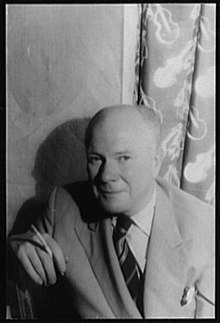Vincent Sheean

James Vincent Sheean (December 5, 1899, Pana, Illinois – March 16, 1975,[1] Arolo, Frz. of Leggiuno, Italy) was an American journalist and novelist.
Career
Sheean's most famous work was Personal History (New York: Doubleday, 1935[2]). It won one of the inaugural National Book Awards: the Most Distinguished Biography of 1935.[3][4][a] Film producer Walter Wanger acquired the political memoir and made it the basis for his 1940 film production Foreign Correspondent, directed by Alfred Hitchcock.
Sheean served as a reporter for the New York Herald Tribune during the Spanish Civil War.[5]
Sheean wrote the narration for the feature-length documentary Crisis (1939) directed by Alexander Hammid and Herbert Kline. He translated Ève Curie's biography of her mother, Madame Curie (1939), into English. Sheean wrote Oscar Hammerstein I: Life and Exploits of an Impresario (1955) as well as a controversial biography of Dorothy Thompson and Sinclair Lewis, Dorothy and Red (1963).
He studied at the University of Chicago, becoming part of a literary circle which included Glenway Wescott, Yvor Winters, Elizabeth Madox Roberts and Janet Lewis while he was there.[6]
Vincent and Diana Forbes-Robertson Sheean were friends of Edna St. Vincent Millay and her husband, Eugen; they spent time together on Ragged Island off the coast of Maine during the summer of 1945.
Books
Partial list, including both fiction and otherwise:
- New Persia (1927) - Iran
- Anatomy of Virtue - (1927) - Psychological romance novel of an American girl who marries an English nobleman.
- American Among the Riffi (1926)
- Gog and Magog
- The Tide (1933) - "If a Messiah Came to Your Town Today, What Would You Think? What Would You Do?".
- Personal History: Youth and Revolution: the Story of One Person's Relationship to Living History (1935)
- Sanfelice (1936) - Historical novel set in Naples
- The Pieces of a Fan (1937)
- A Day of Battle (1938) - Historical novel based on the French victory at Fontenoy in Flanders on May 11, 1745
- Not Peace but a Sword (1939) - Europe. Personal account of events in Prague, Madrid, London, Paris and Berlin during the 12 fateful months between March 1938 and March 1939.[7]
- Lead, Kindly Light: Gandhi & the Way to Peace, Random House (1949). Can Gandhi's non-violent approach lead the world away from violence as the way to settle disputes?
- Between the Thunder and the Sun (1943) Account of being in England during the Battle of Britain.
Notes
- ^ Biography was separately recognized in 1935 and 1936, then subsumed in general Nonfiction.
References
- ^ Vincent Sheean Dies; Author, Traveler (The Washington Post pay per view)
- ^ Chamberlain, John (February 4, 1935). "Books of the Times". New York Times: 13.
- ^ "Books and Authors", The New York Times, 1936-04-12, page BR12. ProQuest Historical Newspapers The New York Times (1851-2007).
- ^ "Lewis is Scornful of Radio Culture: ...", The New York Times, 1936-05-12, page 25. ProQuest Historical Newspapers The New York Times (1851-2007).
- ^ Cecil Eby, Between the Bullet and the Lie: American Volunteers and the Spanish Civil War (New York: Holt, Rineheart and Winston, 1969), p. 237
- ^ "My Friend the Jew". The Atlantic. October 1934.
- ^ Book list from first edition of "Not Peace but a Sword"
Further reading
- Cohen, Deborah. Last Call at the Hotel Imperial: The Reporters Who Took On a World at War (2022) American coverage of 1930s in Europe by John Gunther, H. R. Knickerbocker, Vincent Sheean, and Dorothy Thompson.excerpt
- Dave, Anish. Seeking to Understand the World: Literary Journalism of Vincent Sheean (2023). Vernon Press. [1]
- Cott, Nancy F. Fighting Words: The Bold American Journalists Who Brought the World Home Between the Wars (2020). Basic Books. [2]
- Hamilton, John M. Journalism's Roving Eye: A History of American Foreign Reporting (2009). Louisiana State University Press. [3]
External links
- Biography of Vincent Sheean
- Vincent Sheean at IMDb
- Vincent Sheean at Traces.org
- Sheean's "Holy Land" chapter remains vital to understanding Palestinian conflict
- Vincent Sheean papers at Syracuse University
- Guide to the Vincent Sheean and Ruth Falkenau Correspondence 1919-1986 at the University of Chicago Special Collections Research Center
